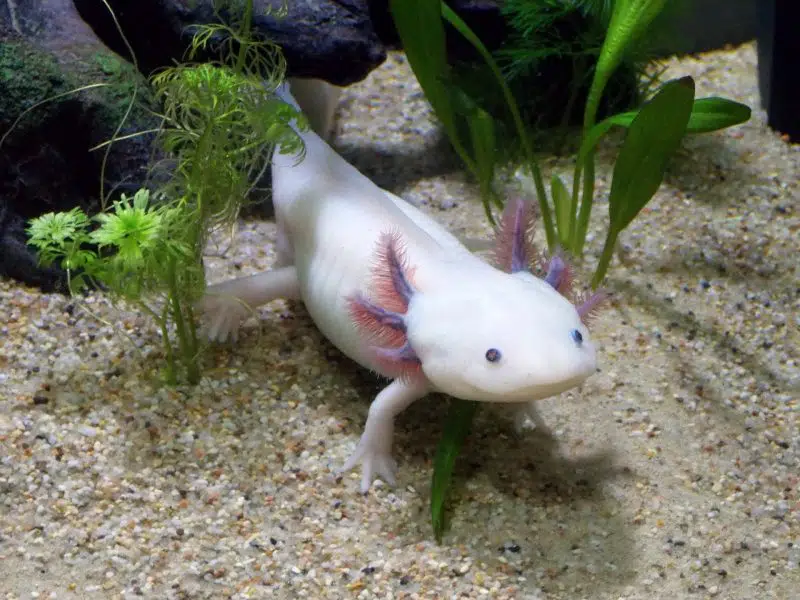Welcome to the fascinating world of “Animals that Start with A”! Let’s dive into the diverse and intriguing realm of animals whose names begin with the first letter of the alphabet.
You can read the entire article or jump to any section.
Overview of Animals that Start with A:
1. Aardvark
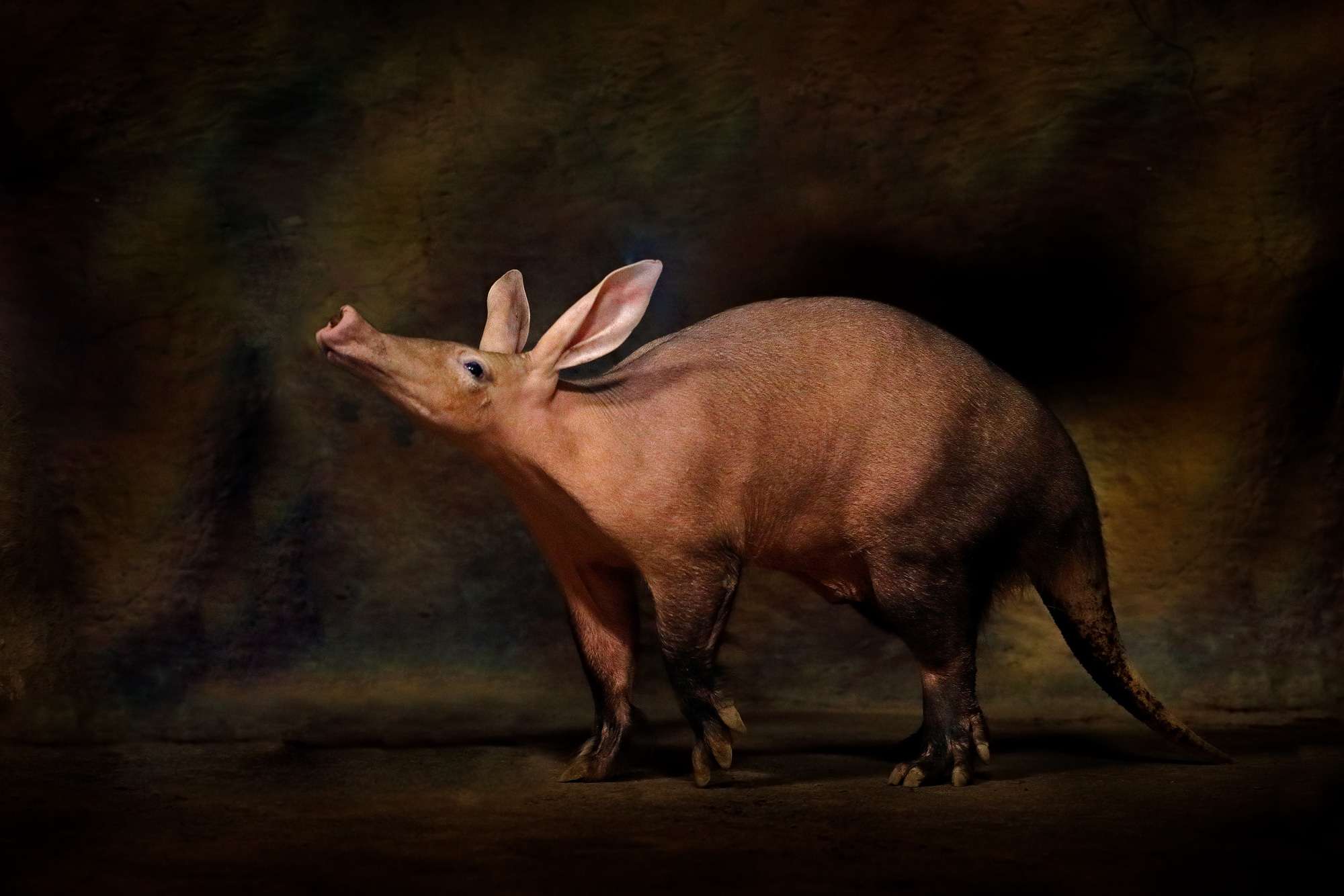
| Scientific Name | Orycteropus afer |
| Where It Lives | Sub-Saharan Africa |
| What It Eats | Ants and termites |
| Conservation Status | Least Concern (LC) according to the IUCN Red List |
Fun Fact: The closest living relatives of the tiny aardvarks are the mighty elephants!
The Aardvark lives in bushland, savannah, woodland, and grassland areas in Sub-Saharan Africa. Where these nocturnal animals spend their days in dark burrows and their evenings looking for termites and ants to eat.
These nocturnal mammals have sticky tongues of up to 12 inches long. They use their long tongues to slurp up termites and ants that they dug up from their mounds and nests by the tens of thousands during the evening. Luckily they can see at night, although they are colorblind. Aardvarks’ sturdy bodies and snouts resemble those of pigs. Their name, coming from the Afrikaans language in South Africa, suitably translates to ‘earth pig’.
2. Aardwolf
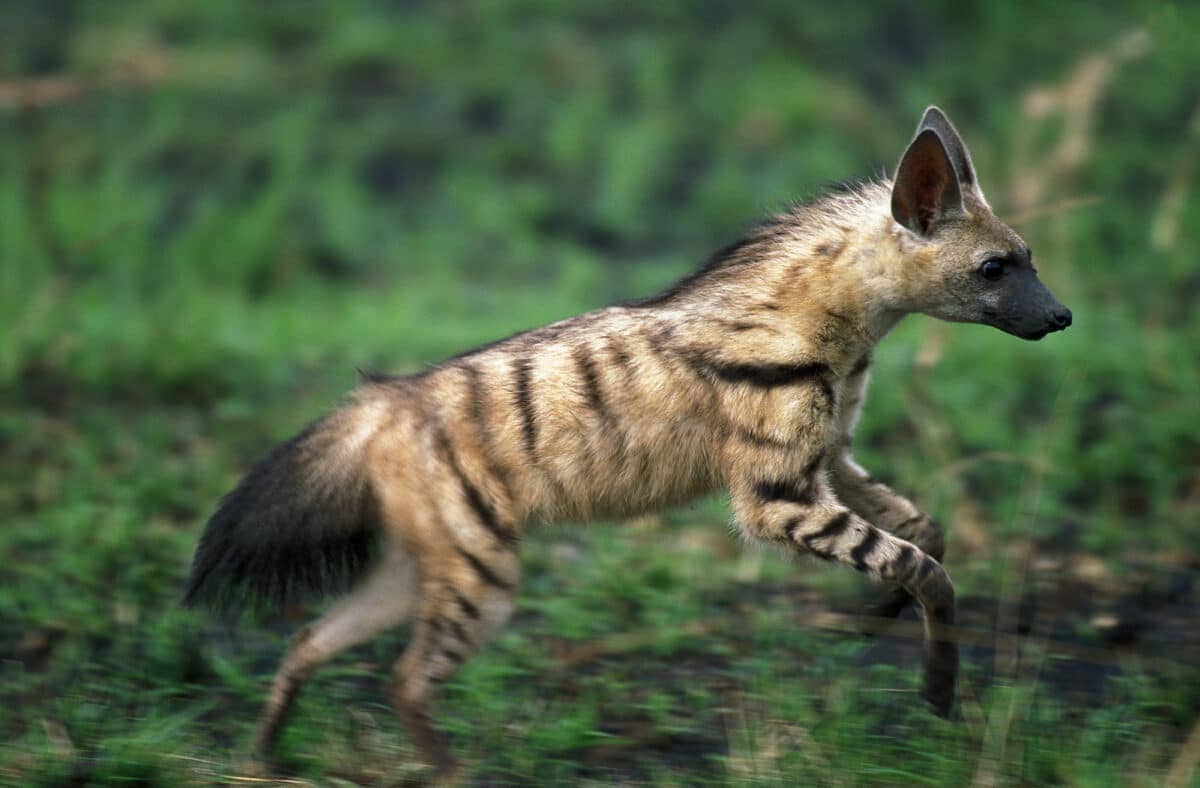
| Scientific Name | Proteles cristatus |
| Where It Lives | Sub-Saharan Africa |
| What It Eats | Termites |
| Conservation Status | Least Concern (LC) according to the IUCN Red List |
Fun Fact: The Aardwolf has five toes on its front paws.
The Aardwolf, closely related to hyenas, avoids mountain regions and lives in bushland and open dry, plain areas in Sub-Saharan Africa.
Although the Aardwolf is related to the scavenging hyena, they do not eat larger animals like their relatives but eat termites instead. However, they do have canine teeth but use them only in defense and for fighting. During confrontations, they also raise their manes to appear more threatening than they are! Mostly nocturnal, Aardwolves might become diurnal in the colder winter months, when they would rather stay in their warm burrows during the evenings. The name Aardwolf directly translates to ‘earth wolf’ in Afrikaans and Dutch, even though these animals are nowhere close to wolves!
3. Addax
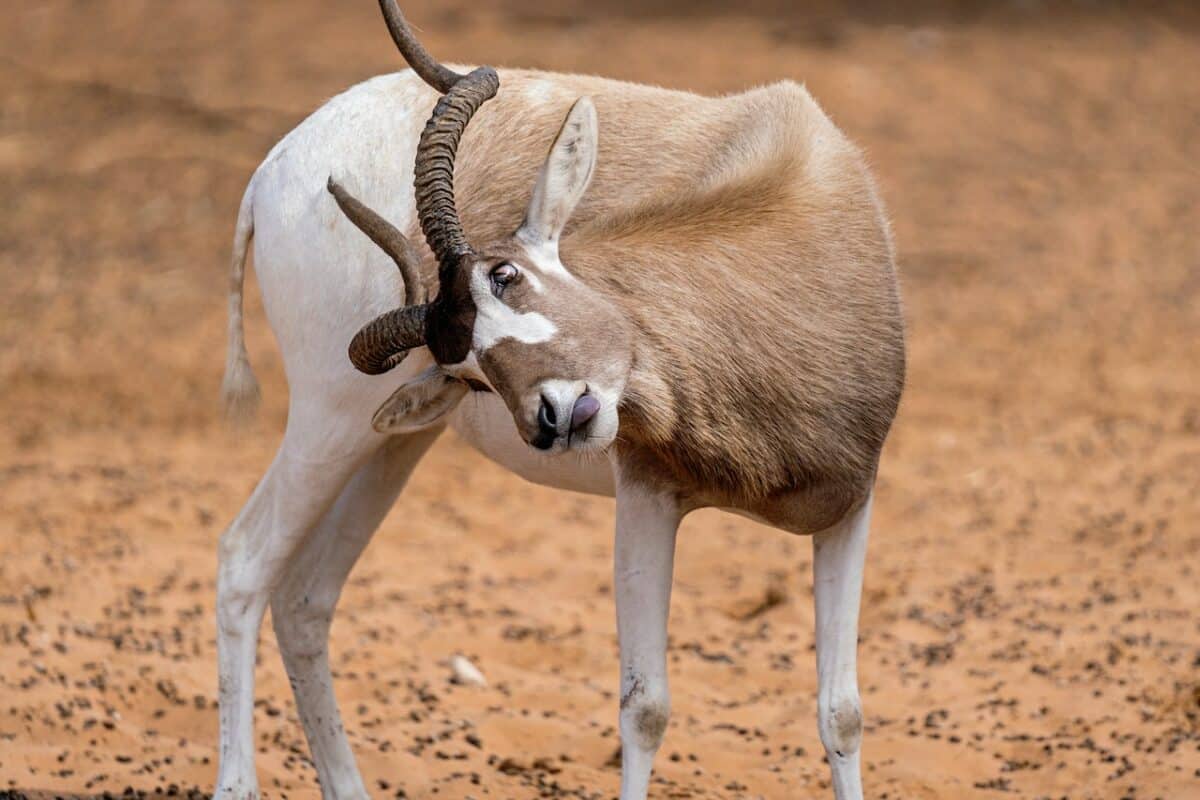
| Scientific Name | Addax nasomaculatus |
| Where It Lives | Sub-Saharan Africa |
| What It Eats | Grasses, leaves, herbs |
| Conservation Status | Critically Endangered (CR) according to the IUCN Red List |
Fun Fact: The Addax can survive without drinking water, receiving all the water it needs from the plants they eat!
The Addax, a beautiful antelope, is native to the Sahara Desert in Africa. Although they have been introduced to many other countries where they live in captivity.
These endangered animals are extremely well adapted to survive in the desert and can survive long periods without water. Even their hooves are splayed to make traveling on sand easier! Addaxes only leave single-file tracks behind them, because when they walk they throw their wide feet sideways and place one foot behind the other. These stunning animals are Critically Endangered with only very few of the species left in the wild. Due to their slow running speeds, they are easy targets for hunters and poachers. Cars chasing them to maximum exhaustion and death, and desertification of savannah lands all lead to the decline in their numbers.
You might also like to read about Animals With The Letter B or Letter C.
4. African Bush Elephant
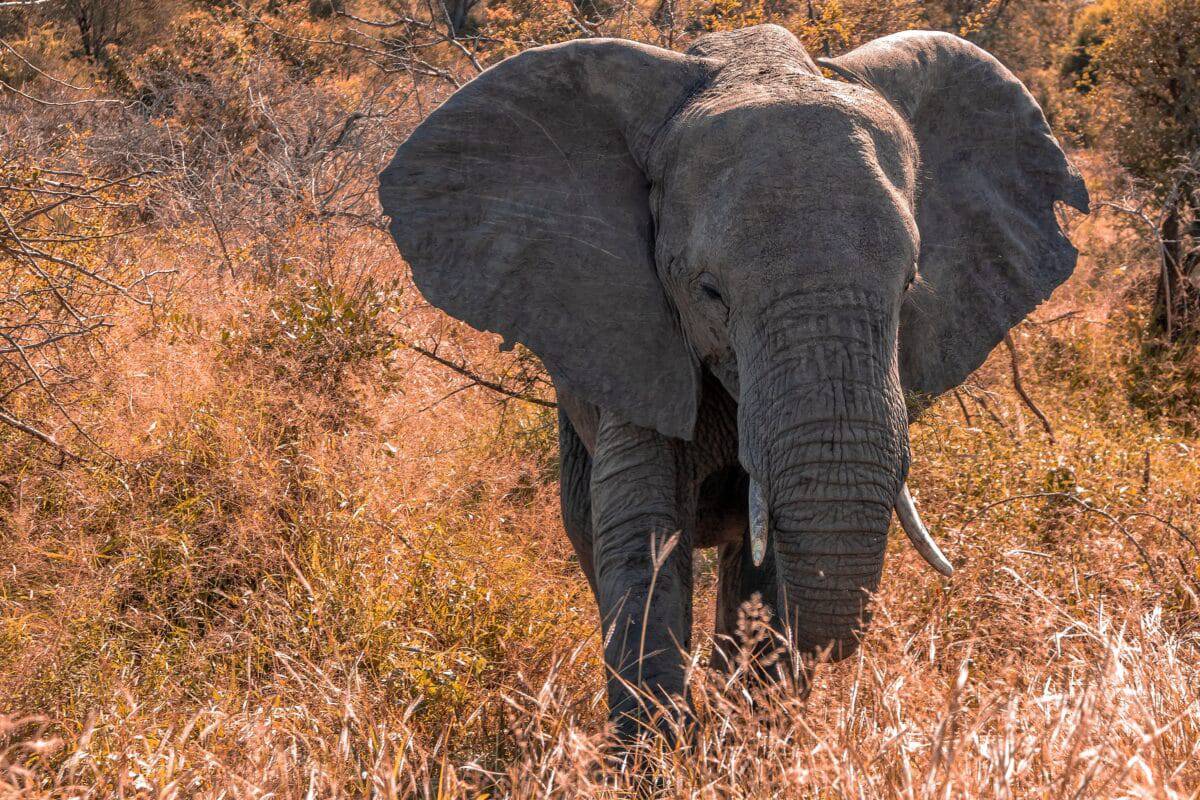
| Scientific Name | Loxodonta africana |
| Where It Lives | Africa |
| What It Eats | Grasses, creepers, herbs, leaves, bark and fruits |
| Conservation Status | Endangered (EN) according to the IUCN Red List |
Fun Fact: The African Bush Elephant replaces its teeth six times in its life.
The magnificent African Bush Elephant lives in woodland, grassland, forest and wetland areas close to water sources in 36 countries across Africa.
These massive animals, some weighing up to 7 tons and reaching a height of 13 feet, are the largest land animals on earth. Their trunks, which can be as long as 6.6 feet, have 150,000 muscle bundles! Not only are their trunks incredibly strong, able to hold the elephant’s body weight, but extremely dexterous. Elephants often use their trunks to pick up a small nut and crack it open before they eat it! These wondrous creatures are listed as endangered because they are hunted by poachers for their skin and ivory.
5. African Grey Parrot
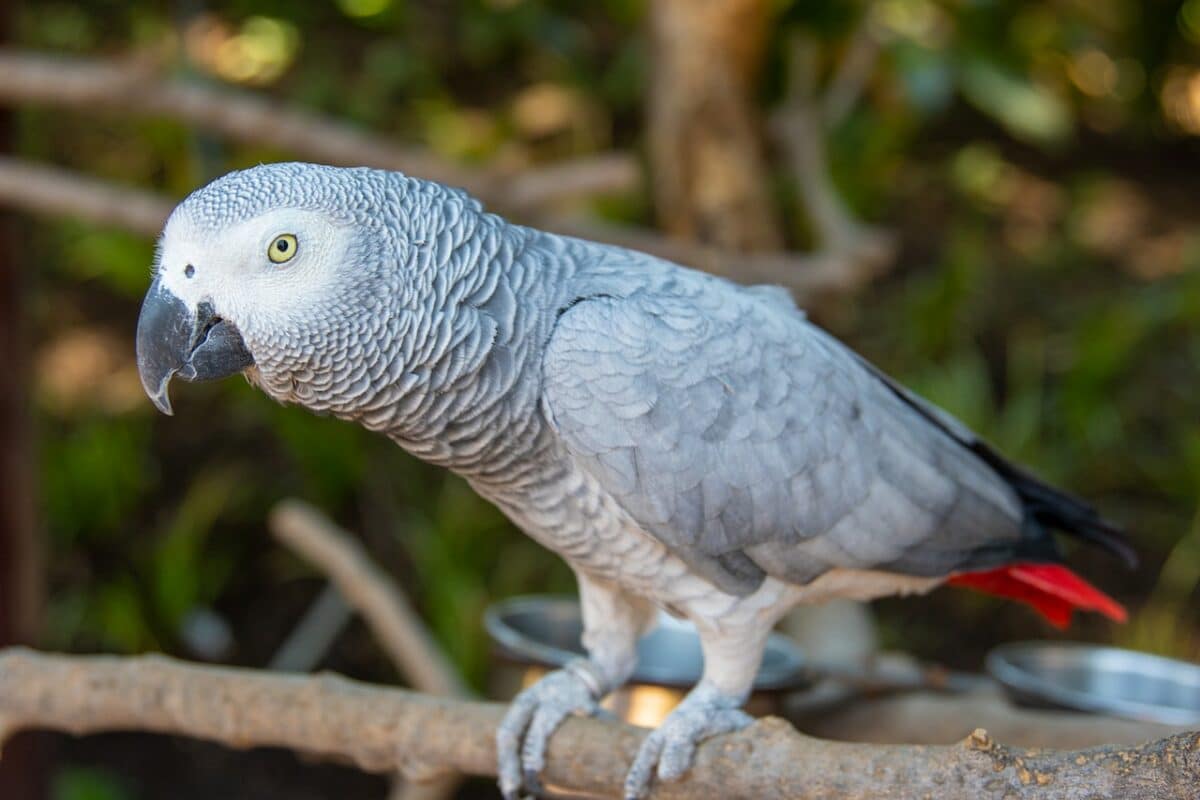
| Scientific Name | Psittacus erithacus |
| Where It Lives | Native to west and central Africa |
| What It Eats | Seeds, nuts, fruit and vegetables |
| Conservation Status | Endangered (EN) according to the IUCN Red List |
Fun Fact: The African Grey Parrot can understand questions and talk back in response.
Once abundant in central and western Africa, the African Grey Parrot is now listed as endangered due to their increased demand in the pet trade. In the wild, they flourish in densely forested areas, as well as more open vegetation areas.
The African Grey Parrot is one of the most intelligent animals on the planet. Making these grey-plumaged and red-tailed birds one of the most loved pets. Entertaining owners with their talk abilities for up to 60 years! However, if you want them to reach this ripe age, do not feed them avocados – it is toxic to birds.
6. Albatross
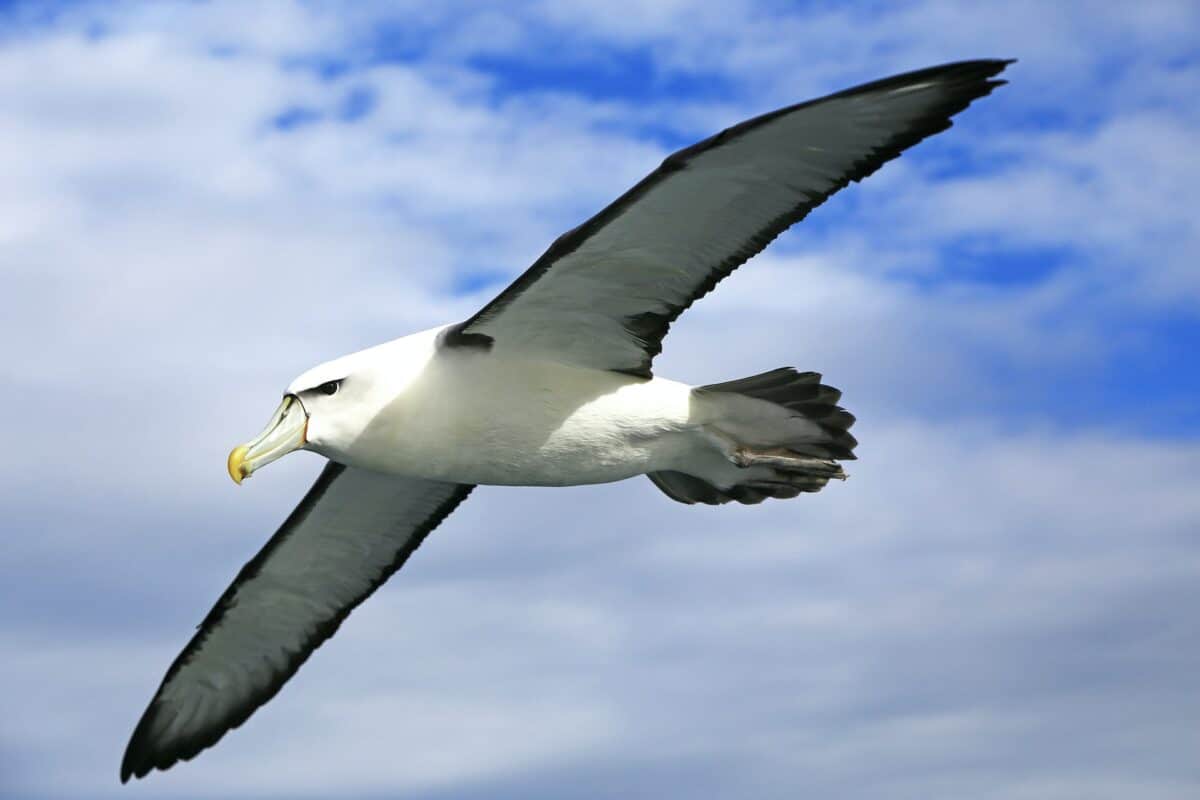
| Scientific Name | Diomedeidae |
| Where It Lives | Southern Ocean and North Pacific |
| What It Eats | Fish, crustaceans, jellyfish and cephalopods |
| Conservation Status | Most species are Endangered (EN) according to the IUCN Red List |
Fun Fact: The wandering albatross’ wingspan is the largest of all birds and measures up to 12 feet!
There are 12 species in the Albatross family. And these seabirds mostly occur in the Southern Ocean and the North Pacific, only going to land to breed on small islands.
These incredible seabirds can spend years soaring across the open ocean without touching land. They will only touch the water surface for short periods to feed on prey they smell up to 12 miles away. With many albatross species marked as endangered, they are at threat of extinction due to human activity. Many die at sea due to fishing activities and ocean plastics. In the wild, the average lifespan of an Albatross is 30 years but the oldest recorded albatross was Widom, who lived to 50.
7. Aldabra Giant Tortoise
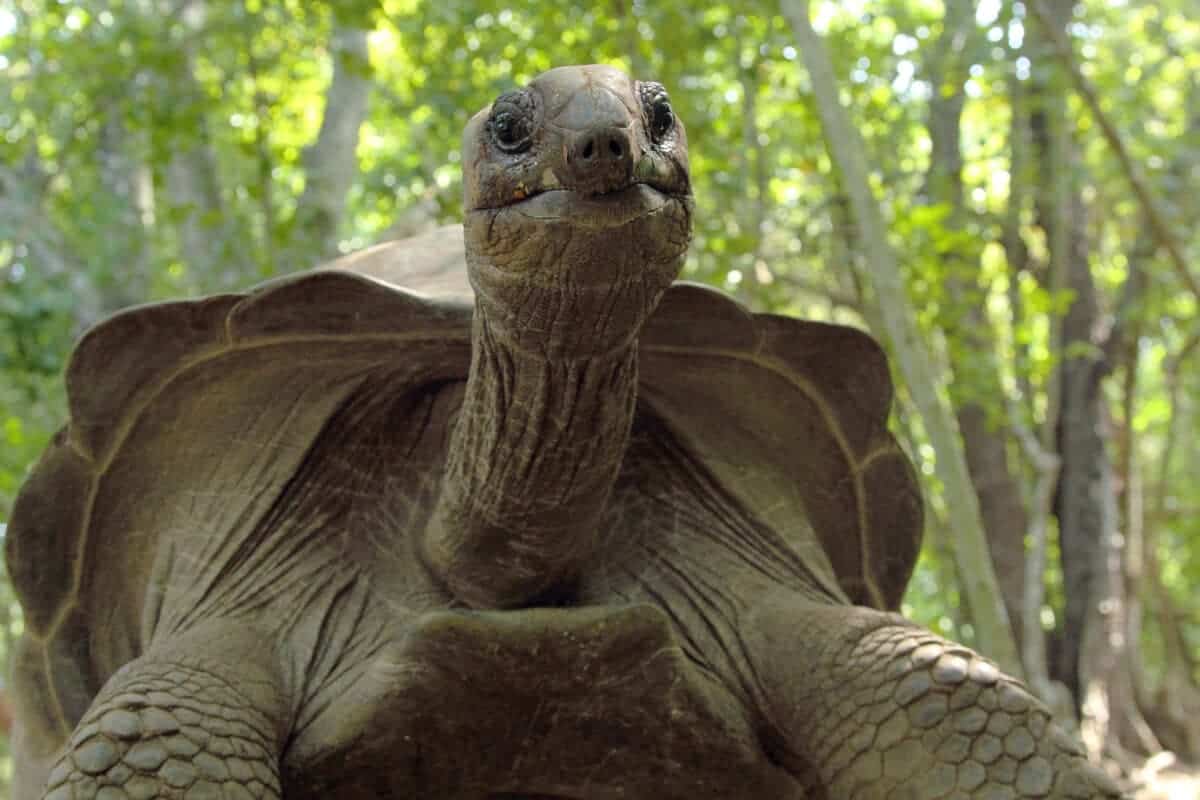
| Scientific Name | Aldabrachelys gigantea |
| Where It Lives | Seychelles, Madagascar and Tanzania |
| What It Eats | Fruit, leaves, grasses and other vegetation |
| Conservation Status | Vulnerable (VU) according to the IUCN Red List |
Fun Fact: Aldabra Giant Tortoises have long lifespans; one lived for up to 255 years.
The Aldabra Giant Tortoise is endemic to the Seychelles and can be found in coastal beaches and dunes, mangrove swamps, and scrub forests in Madagascar and Tanzania as well.
Marked as vulnerable on the IUCN Red List due to past exploitation, the Aldabra Giant Tortoise is the only giant tortoise surviving in the wild today. These burrowing animals are massive with their large domed shells and 3.6-foot lengths. But even for these huge sizes, their necks are incredibly long. Allowing them to reach tree branches up to 3.3 feet from the ground! These incredible reptiles are slow growers – only reaching maturity at ages between 20 and 30 years.
8. Alpaca
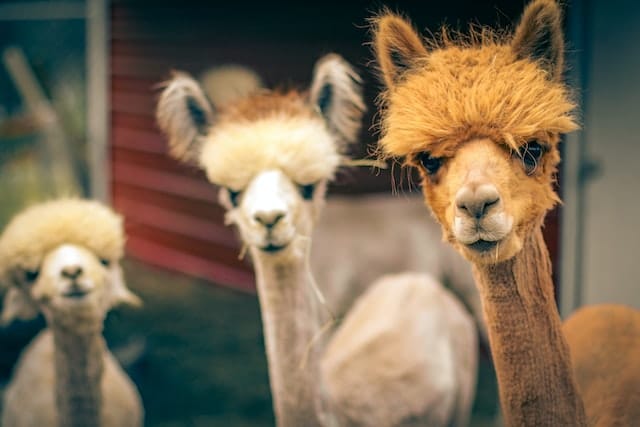
| Scientific Name | Lama pacos |
| Where It Lives | Peru, Ecuador, Chile, and Bolivia |
| What It Eats | Grass and hay |
| Conservation Status | Not Endangered |
Fun Fact: Alpacas and Llamas can interbreed and their offspring are called huarizos.
The Alpaca, a close relative to Llamas, is often found in mountain areas with temperate conditions across most of South America and is native to Peru. These members of the camel family also live across the globe in captivity.
Smaller than Llamas, these mammals can be seen in 22 different colors! They are bred for their wool, which is waterproof and used to make various wool items. Just like other members of the camel family, Alpacas spit when they feel danger or agitation. These social animals use body language to communicate and are often heard humming which indicates emotions ranging from boredom to satisfaction.
9. Amazon River Dolphin
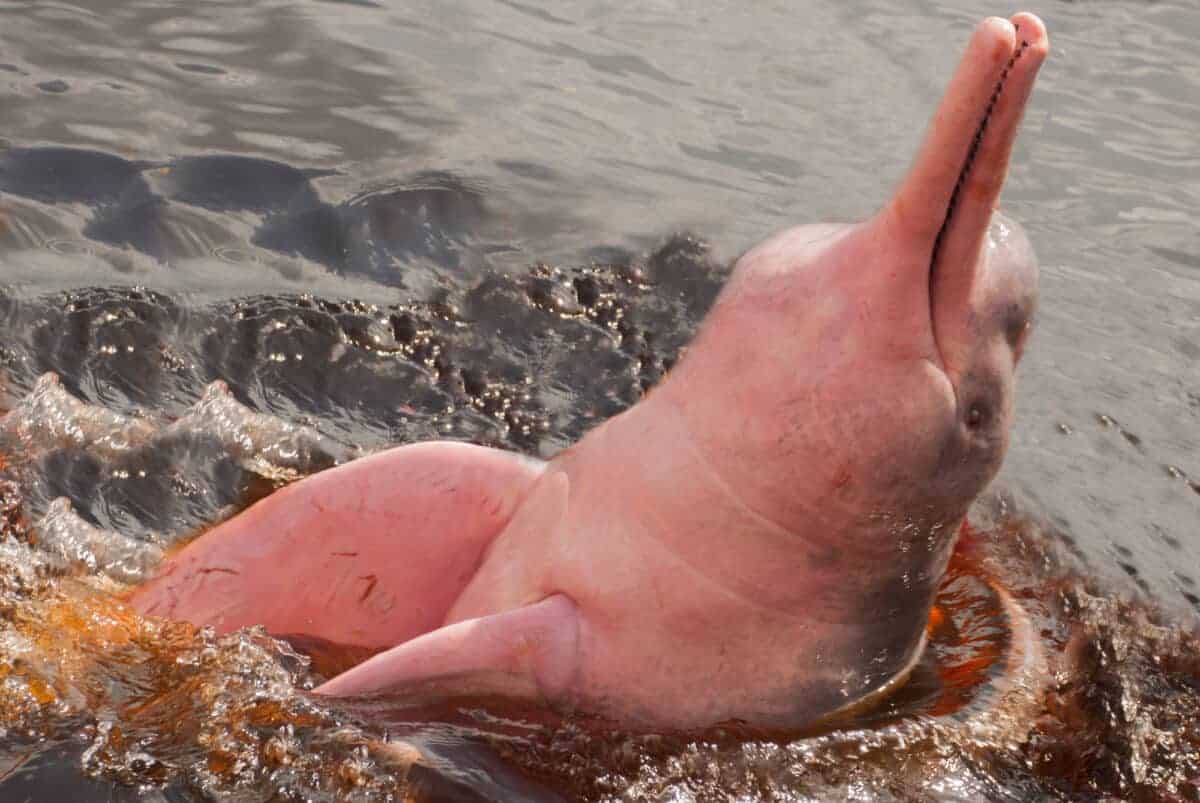
| Scientific Name | Inia geoffrensis |
| Where It Lives | South America |
| What It Eats | Variety of fish |
| Conservation Status | Endangered (EN) according to the IUCN Red List |
Fun Fact: The Amazon River Dolphin blushes pinker when excited – just like humans!
The Amazon River Dolphin, also known as the Boto, is an endangered freshwater dolphin found in the basins of the Amazon and Orinoco Rivers.
The Amazon River Dolphin is incredibly intelligent, with 40% more brain capacity than humans. And when fully grown, they can weigh up to 400 pounds and be 9 feet long. Although massive, these freshwater dolphins are incredibly agile. The vertebrae in their necks are unfused, allowing them to maneuver around obstacles with grace. They are also able to paddle forward with one flipper and backward with another to make tight turns and are often seen swimming upside down.
10. Amur Leopard
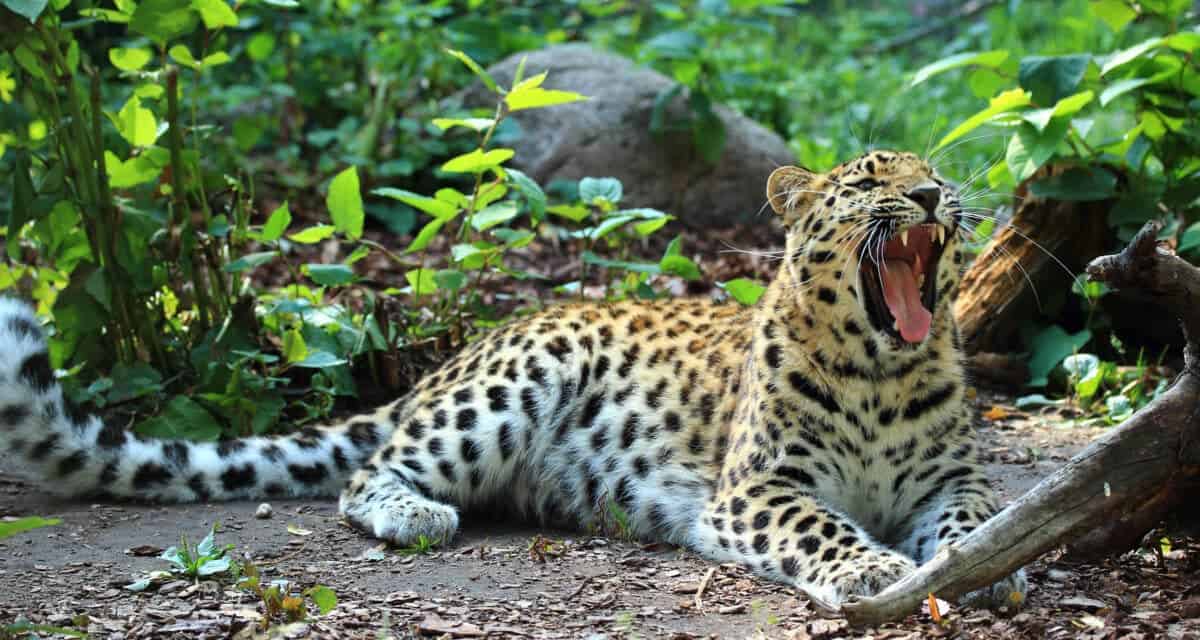
| Scientific Name | Panthera pardus orientalis |
| Where It Lives | Russia and China |
| What It Eats | Boars, rodents and deer |
| Conservation Status | Critically Endangered (CR) according to the IUCN Red List |
Fun Fact: The Amur leopard has tiny hooks on its tongue to help it lick the meat off bones.
The Amur Leopard prefers living in pine and deciduous forests and avoids grassland and highly populated areas on the border of Russia and China.
With only a few of these big cats left in the wild, they are quite hard to find. But if you do find them, it will likely be in a freezing area as they love the cold. In summer seasons their coat is much shorter than their winter coats and each Amur Leopard coat has a unique spot pattern, allowing them to be individually identified. These solitary and nocturnal cats are big tree climbers. Often being so well camouflaged that they are only noticeable by their swinging tail
11. Anaconda
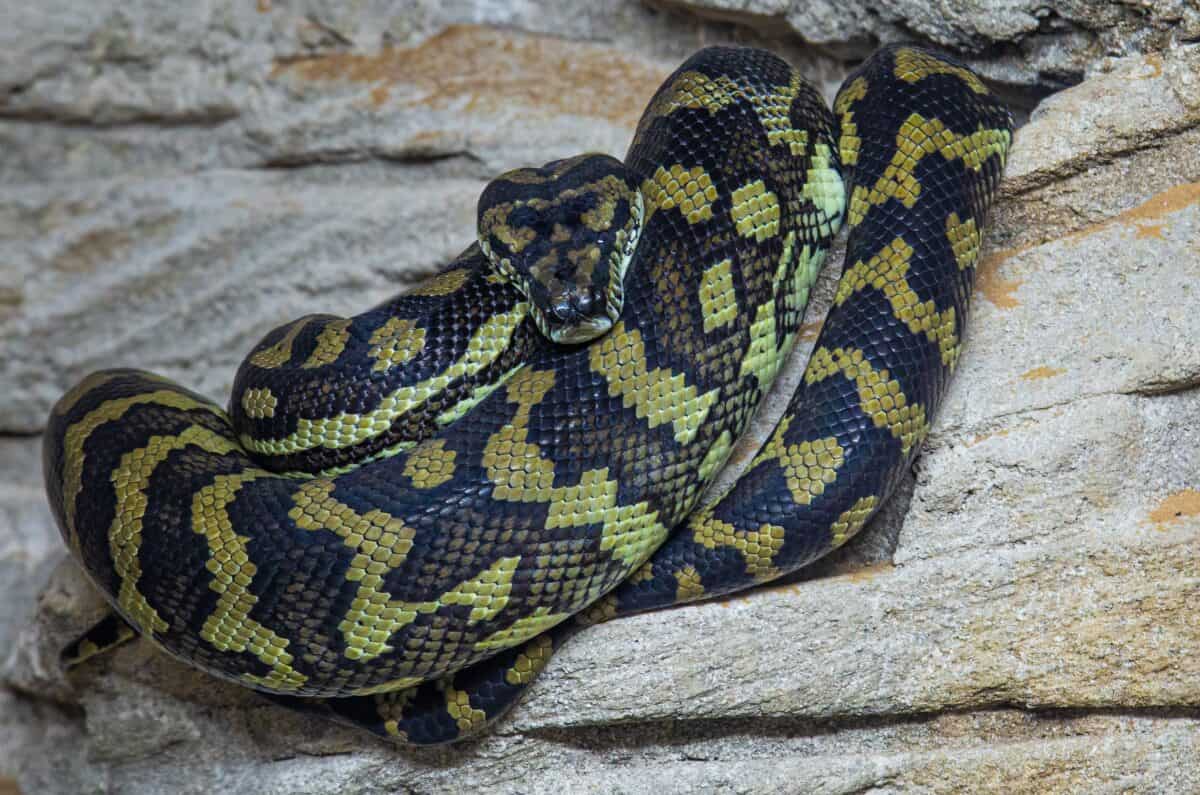
| Scientific Name | Eunectes murinus |
| Where It Lives | South America |
| What It Eats | Deer, fish, reptiles, dogs, sheep and many other animals |
| Conservation Status | Not Endangered |
Fun Fact: Anacondas can hold their breath for 10 minutes underwater.
The semi-aquatic Anaconda lives in rainforest, freshwater, and savanna areas where the water is not too deep in South America.
Anacondas are nocturnal animals that lead a solitary life and can move extremely fast in the water but a bit slower on land. These apex predators are opportunistic hunters and will eat almost any animal that they can catch and swallow. Like other boa species, Anacondas are non-venomous and one large meal can keep them full for long periods at a time. These massive snakes reach lengths of 15.1 feet and as one of the heaviest snakes weigh around 154 pounds.
12. Angel Fish
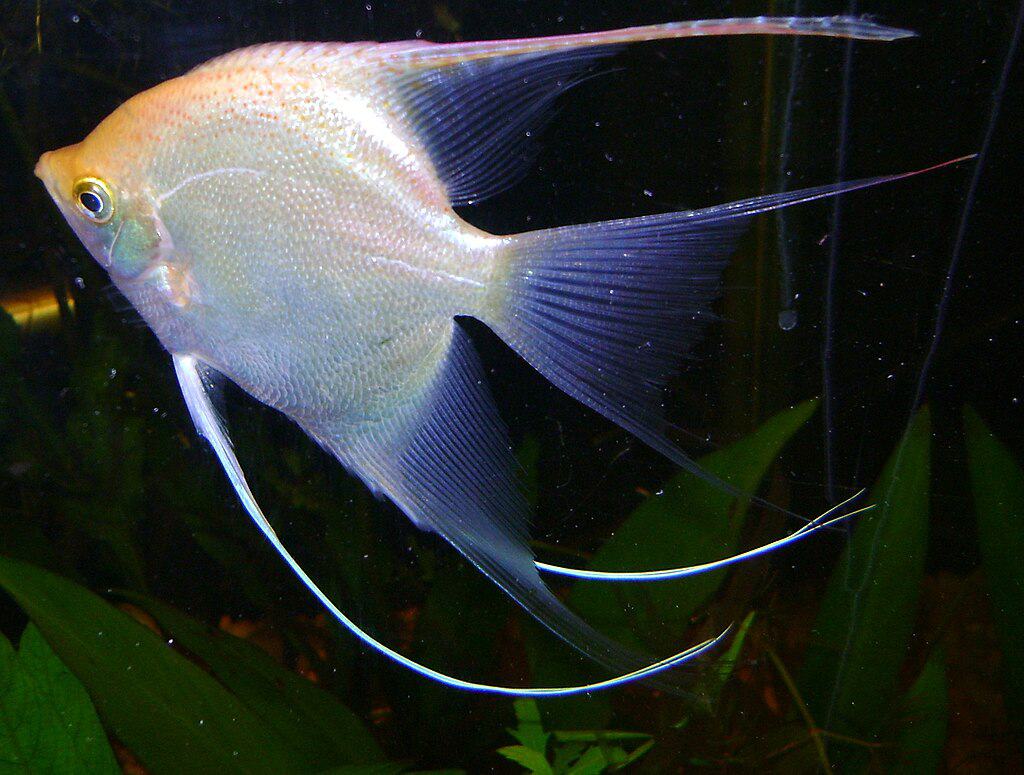
| Scientific Name | Pterophyllum scalare |
| Where It Lives | Peru, Colombia, Brazil |
| What It Eats | Tiny fish fry, juvenile fish, shrimp, worms, mosquito larvae and waterbugs |
| Conservation Status | Not Endangered |
Fun Fact: Despite their innocent appearance, Angel Fish are quite aggressive and territorial.
The freshwater angel fish lives in swampy or flooded areas where the water is slow moving and still in Peru, Colombia, and Brazil.
The Angel Fish loves areas with densely packed vegetation to provide protection from their predators and safe places to lay their eggs. During breeding season these solitary fish form monogamous breeding pairs where the female lays the eggs and the male fertilizes these eggs. Both parents play a role in caring for and protecting these eggs and between 100 and 1000 offspring emerge. These freshwater fish can change their color based on their mood.
13. Angler Fish
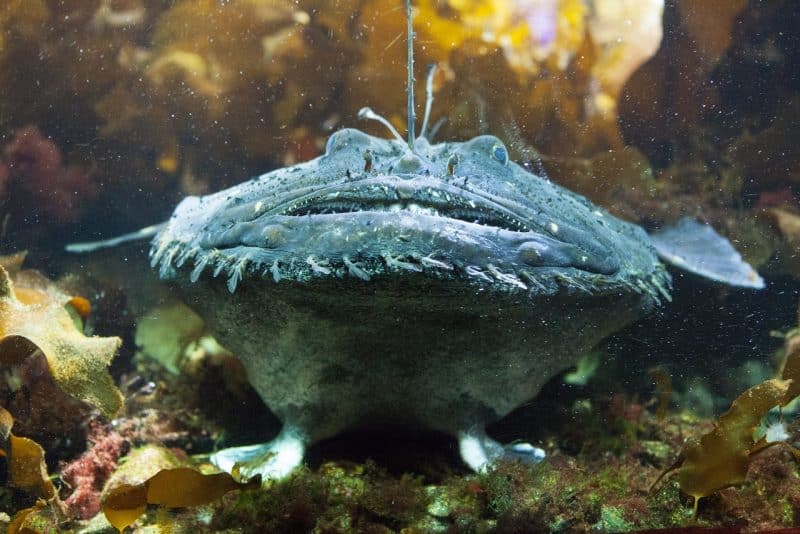
| Scientific Name | Lophius piscatorius |
| Where It Lives | Northern Atlantic Ocean and Mediterranean Sea |
| What It Eats | Small fish, shrimp, and invertebrates |
| Conservation Status | Least Concern (LC) according to the IUCN Red List |
Fun Fact: Some species of angler fish physically merge after mating, becoming fully symbiotic.
The intriguing angler fish lives at underwater levels so deep no light reaches, called the midnight zone. Where they lie partially covered in sand or mud and wait for prey.
Luckily, they have a light-emitting growth protruding from their heads called their illicium. They use these growths to lure prey while they lie still and wait to catch with their wide mouth and teeth. These fish are known to lay their eggs as deep as 3280 feet below the ocean surface during the breeding season, where fertilization occurs externally like most other fish.
14. Angora Goat
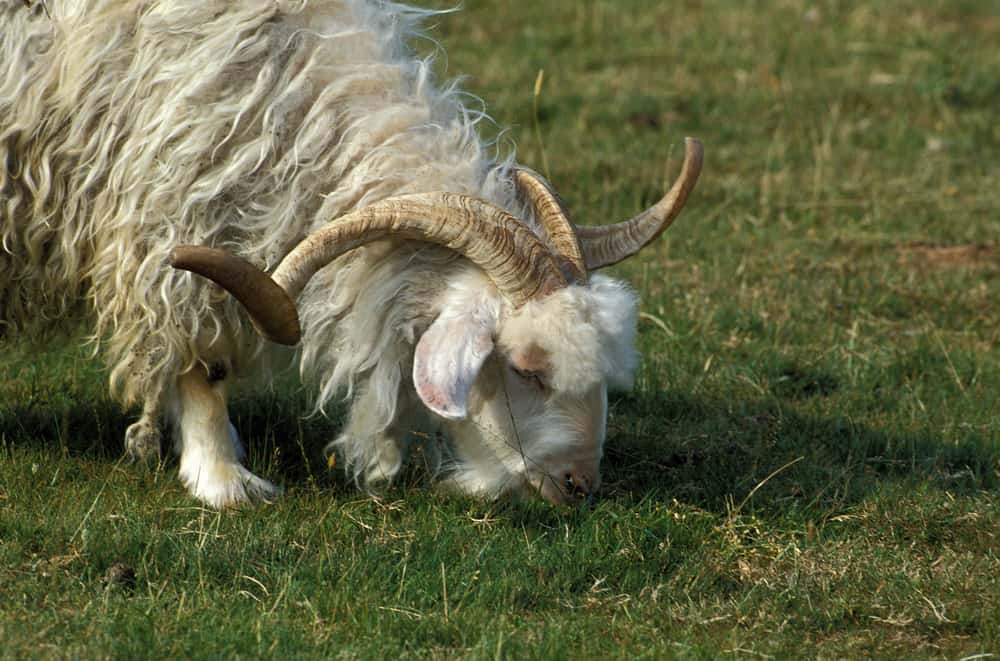
| Scientific Name | Capra aegagrus hircus |
| Where It Lives | Asia, Africa, America, Europe and Oceana |
| What It Eats | Patsure |
| Conservation Status | Pasture |
Fun Fact: Angora goats are the only goats that produce hair.
The Angora goat is popular to farm with for their hair, called Mohair. The largest population of these goats is in South Africa – which also produces the highest quantities of mohair!
The angora goat is a friendly and laid-back goat, however, they are extremely curious! Often farmers have to use electrical fences to keep them out of areas where they might cause damage (or get hurt). These relatively small goats live up to 15 years old and continue to breed yearly until about two years before their death. Offspring drink their mother’s milk and farmers often provide supplemental nutrients during these seasons.
15. Antarctic Scale Worm
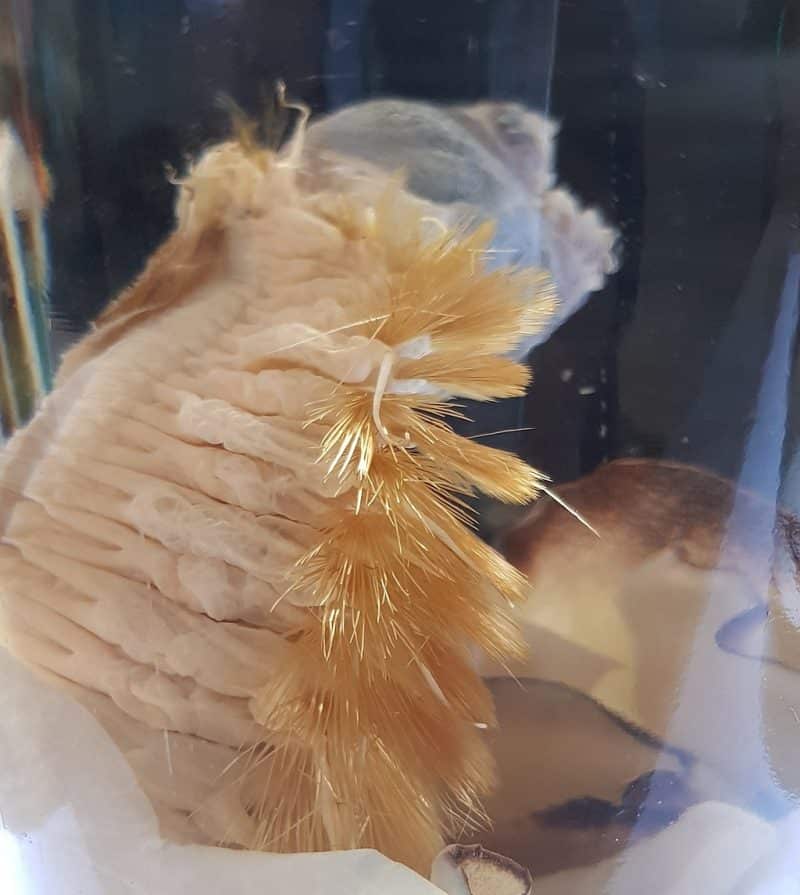
| Scientific Name | Eulagisca gigantea |
| Where It Lives | Antarctic Ocean |
| What It Eats | Spiders and other marine life |
| Conservation Status | Least Concern (LC) according to the IUCN Red List |
Fun Fact: The Antarctic Scale Worm’s proboscis retracts into its body when not in use.
The Antarctic Scale Worm is an odd-looking work living in the deep and cold waters of Antarctica close where it conceals itself under mud and sand on the ocean floor.
This strange-looking animal is the size of a typical squirrel or rat, making them one of the largest scale worm species. Growing to 8 inches, these massive worms have 40 body segments covered in 15 pairs of ‘armor’ scales called elytra. Its head is about a quarter the size of its whole body and retracts when it is not feeding. Their long snout or proboscis has powerful jaws and teeth that they use to tear into their prey.
You might also like to read about Animals That Start With The Letter D or Start With the Letter E.
16. Ant
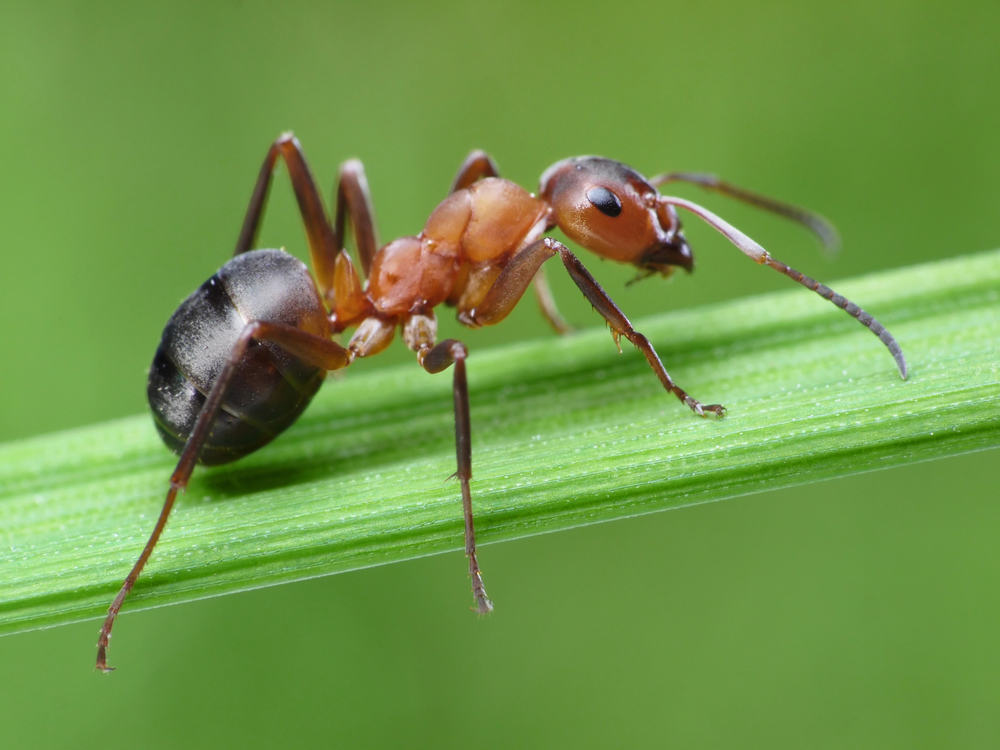
| Scientific Name | Formica rufa |
| Where It Lives | Worldwide |
| What It Eats | Leaves, seeds, fruit, honeydew, nectar and various other foods they find |
| Conservation Status | Not Endangered |
Fun Fact: Ants are incredibly strong and can lift 20 times their body weight!
The mighty strong Ant lives around the world in nests made of twigs, sand, and mud.
Three types of ants live in a colony: the queen, female worker ants, and male ants. The queen is the only ant able to lay eggs, and once she is mature enough to do so she spends the rest of her life laying millions of eggs. Some of the worker ants act as soldiers who gather food, protect the colony, and fight other colonies for their space and food resources. If they beat the colony they take their eggs and these are then forced to work for the winning colony.
17. Anteater
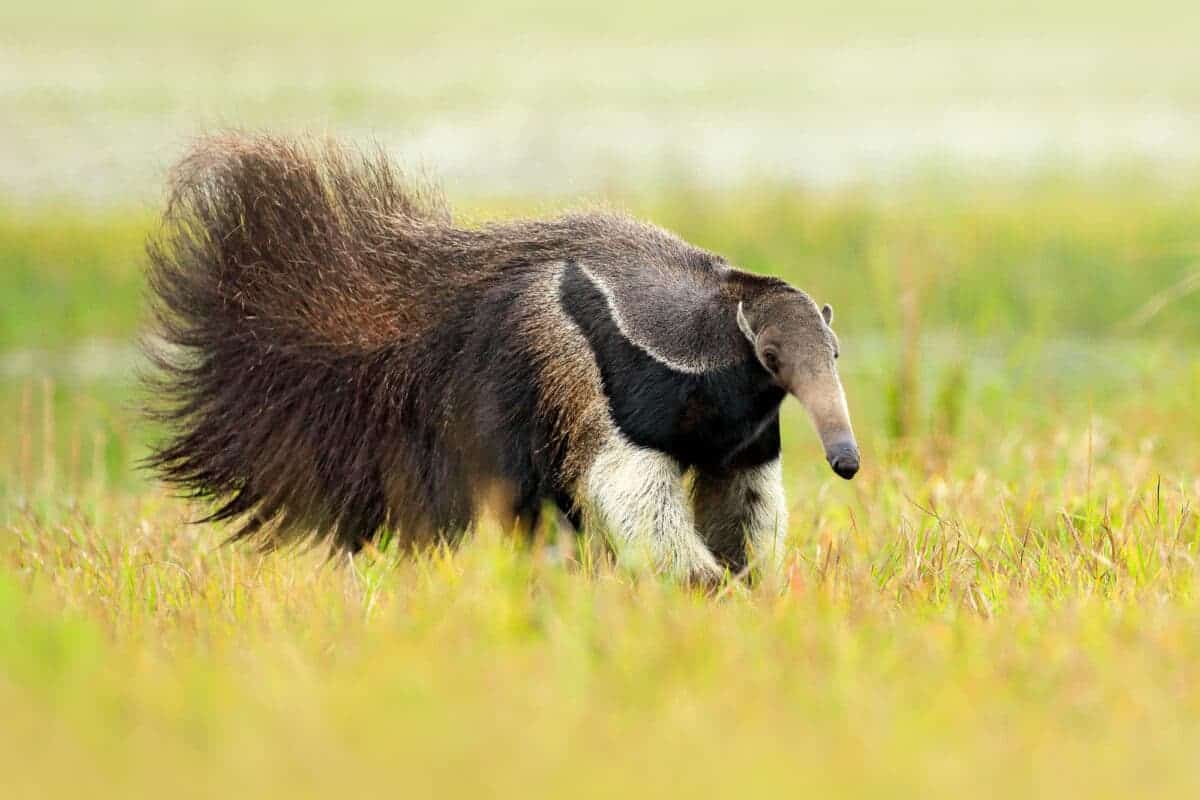
| Scientific Name | Myrmecophaga tridactyla |
| Where It Lives | Central and South America |
| What It Eats | Ants and termites |
| Conservation Status | Vulnerable (VU) according to the IUCN Red List |
Fun Fact: Anteater tongues can reach two feet in length.
The giant Anteater is a terrestrial animal living in rainforests, savannas, dry tropical forests and open grasslands across Central and South America.
These solitary wandering animals mostly eat a diet of ants and termites. They collect these insects with their incredibly long tongues and don’t have any teeth. Except for mating season, when anteaters run into each other in the wild it is not uncommon that they ignore each other and carry on with their own thing, or even run away! Anteaters use their front legs to fight, and with the help of their tail can stand on their hindlegs.
18. Arabian Horse
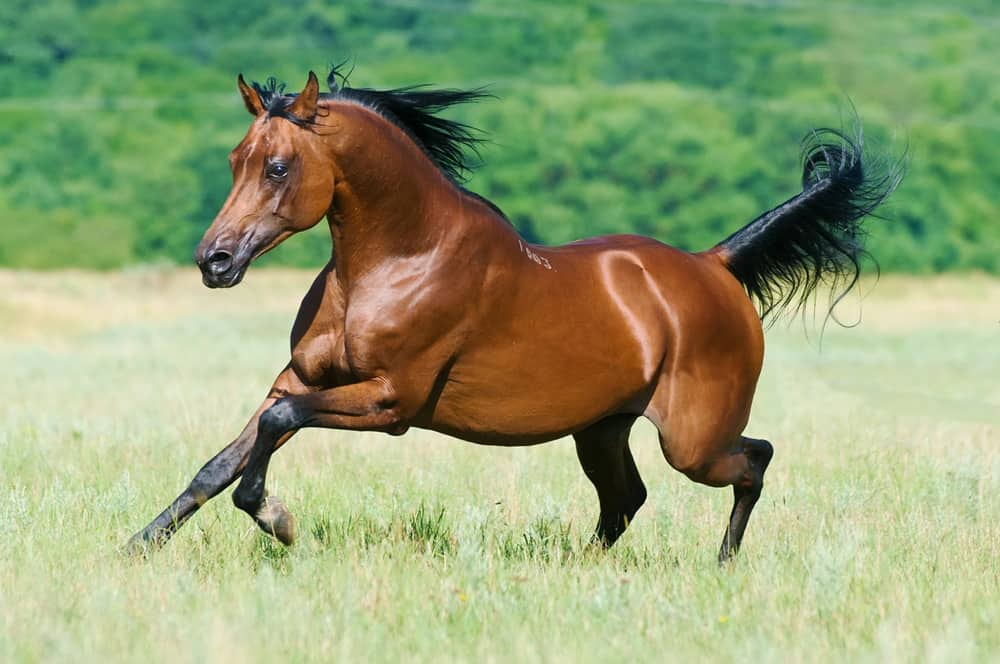
| Scientific Name | Equus ferus caballus |
| Where It Lives | Origin in the Middle East and North Africa |
| What It Eats | Hay, fresh grass, grains and some fruit and veg |
| Conservation Status | Not Endangered |
Fun Fact: Arabian horses are one of the oldest modern horse breeds.
The Arabian Horse, gracious and beautiful, was originally bred by nomads in the extremely hot deserts of the Arabian peninsula.
Known for their intelligence, gracefulness, speed, and beauty these horses are some of the qualities that make them popular amongst riders and farmers around the world. Purebred Arabian colors include roan, grey, chestnut, bay, and black. However, all of these majestic horses have black skin under their coats that provides protection from the harsh desert sun. These horses are used for many activities ranging from equestrian sports to therapeutic horseback riding programs.
19. Arapaima
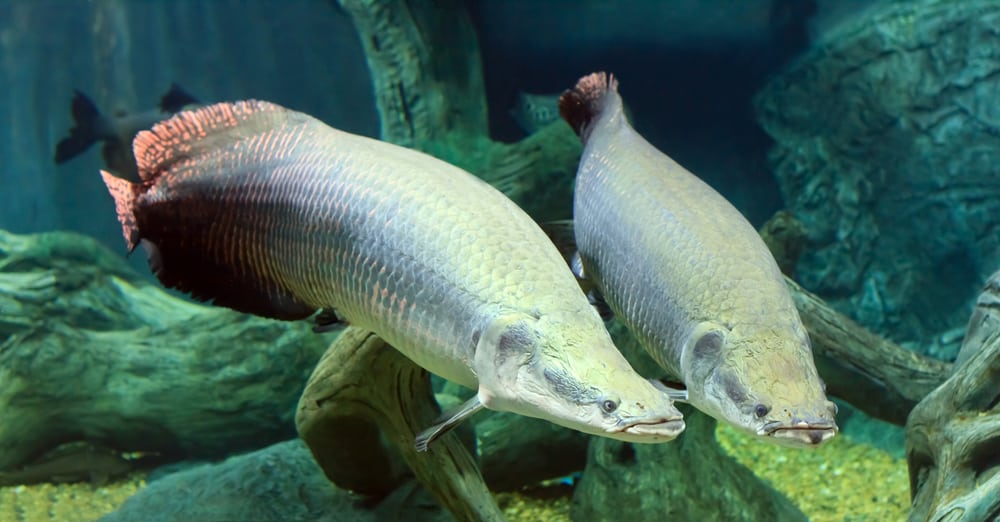
| Scientific Name | Arapaima gigas |
| Where It Lives | Brazil, Guyana and Peru. |
| What It Eats | Mostly fish |
| Conservation Status | Not Endangered |
Fun Fact: Arapaimas breathe air and only the young ones have gills.
The Arapaima, the largest freshwater fish, are found in the freshwater basin of the Amazon River.
These long, heavy and thick-scaled fish breathe oxygen, meaning that they have to come up to the surface regularly for air. These massive fish are commonly around 6 feet in length, but some as large as 15 feet have been reported, and can weigh up to 440 pounds! Their thick scales act as armour protecting them from predators. They are known as ‘gulpers’ meaning they just open their large mouths to create a vacuum that sucks in nearby foods!
20. Arctic Wolf
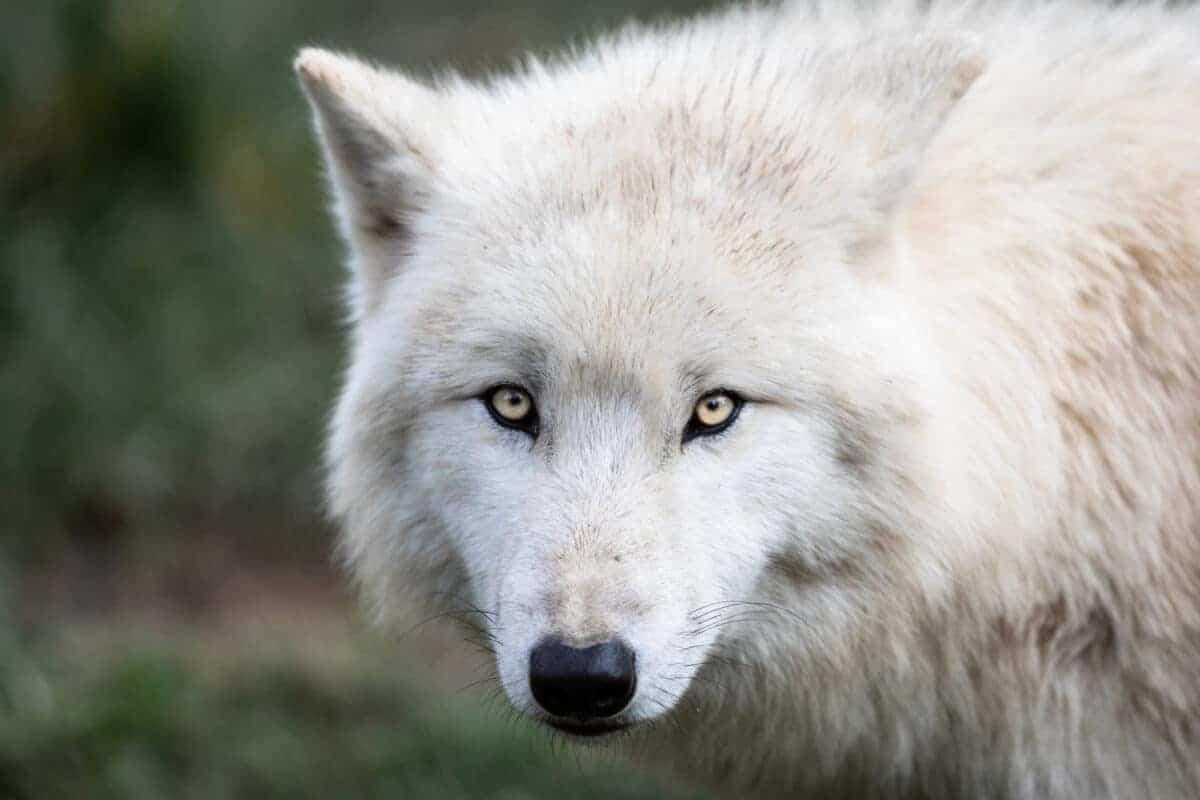
| Scientific Name | Canis lupus arctos |
| Where It Lives | Most northern parts of North America |
| What It Eats | Muskoxen, Arctic hares, lemmings, foxes and birds |
| Conservation Status | Not Endangered |
Fun Fact: Arctic wolves are born with blue eyes, but those change to yellow or gold as they grow older.
The beautiful Arctic wolf lives in the snowy temperatures of ice-covered Arctic regions of Greenland and North America.
They are social animals with a set pack hierarchy that is communicated through their body language. In these packs, it is usually only the alpha male and female who mate and procreate. However, the whole pack shares the responsibility of caring for the young. Even when they go out hunting one of the pack members will stay behind to take care of the pups. Well suited to their cold habitats, Arctic wolves have thick coats of white fur, a short nose and small ears to conserve body heat.
21. Armadillo
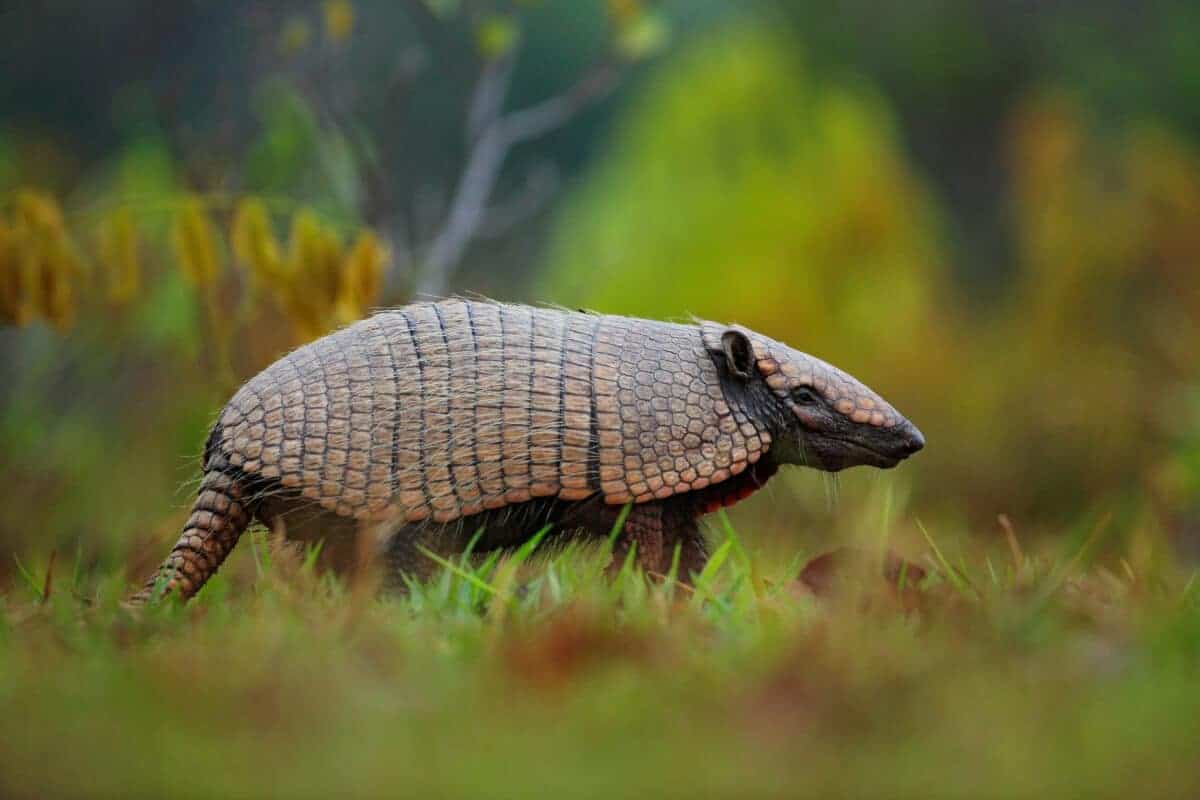
| Scientific Name | Dasypodidae |
| Where It Lives | South America |
| What It Eats | Ants, Beetles, termites, cockroaches, grubs and scorpions |
| Conservation Status | Not Endangered except one species is Vulnerable (VU) according to the IUCN Red List |
Fun Fact: Armadillos can roll up into a ball for maximum protection.
The unique Armadillo species all live in the warm climates of semi-deserts, rainforests, and grasslands of South America.
The armadillo is the animal version of an armored tank with their overlapping scales and compact shape that brush away a lot of the damage that comes their way. These insect eaters have incredibly long and sticky tongues that they use to retrieve huge amounts of ants from their nests and slurp them up! When frightened or startled, armadillos jump up to 5 feet high! This scares off most predators who attempt a quick meal. These cute creatures are also strong swimmers and can hold their breath for almost 6 minutes.
22. Arizona Bark Scorpion
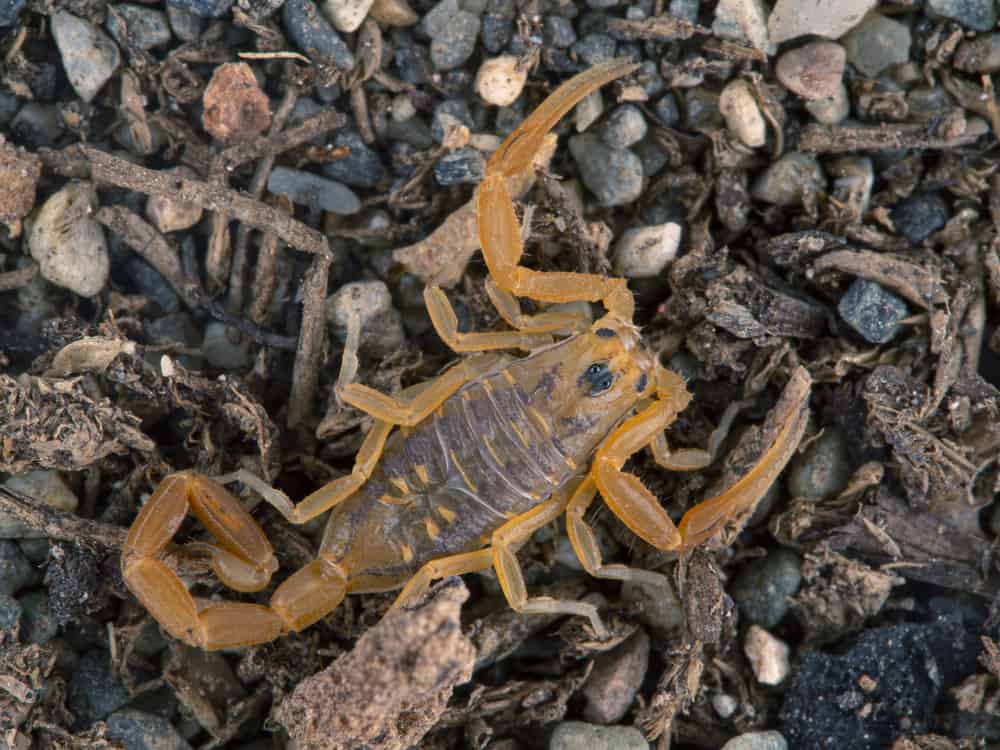
| Scientific Name | Centruroides sculpturatus |
| Where It Lives | Southwestern U.S. and northwestern Mexico |
| What It Eats | Insects, spiders, centipedes, and other spiders |
| Conservation Status | Not Endangered |
Fun Fact: Arizona Bark Scorpions glow green under UV lights!
The Arizona Bark Scorpion lives in the southwestern United States and northwestern Mexico. These scorpions are well adapted to desert conditions with a waxy layer on their exoskeleton to prevent moisture loss in the heat.
The female Arizona Bark Scorpion only grows about seven inches long, and the males don’t even get to four inches. The tiny arachnid’s sting packs a punch! They have lethal venomous stings, which is especially dangerous for children and the elderly. These yellow scorpions love climbing trees, and even house walls – the only scorpion in the Southwest that can!
23. Avocet
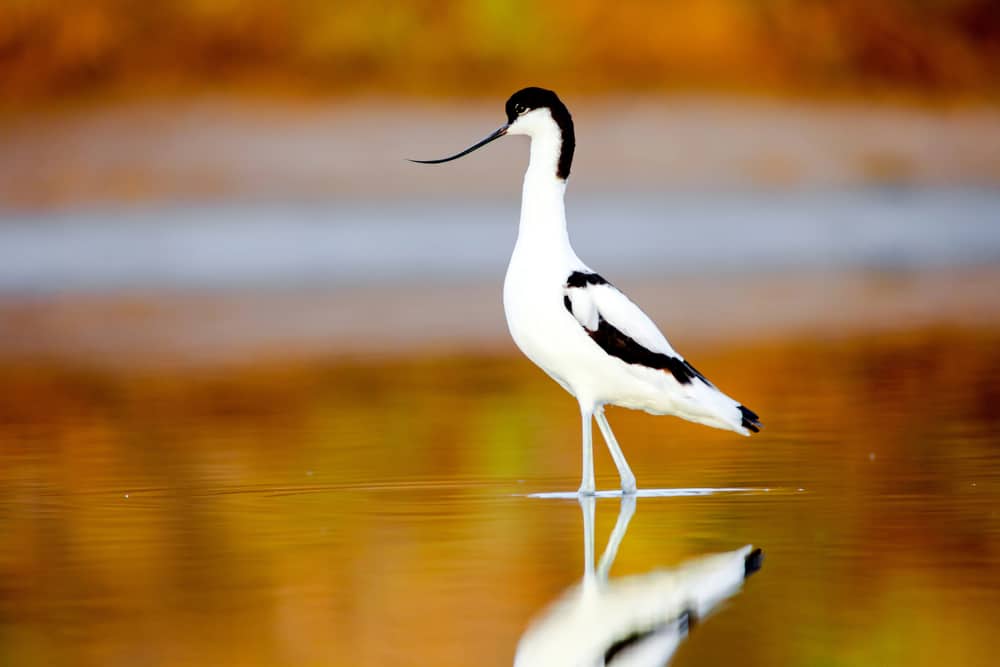
| Scientific Name | Recurvirostra |
| Where It Lives | U.S., Australia, Chile, Peru, Bolivia, Europe, Asia, Mexico, Canada |
| What It Eats | Beetles, brine flies, midges, fairy shrimp, amphipods and water fleas |
| Conservation Status | Least Concern (LC) according to the IUCN Red List |
Fun Fact: The Avocet can build nest mounds up to a foot tall.
The four Avocent species live in wetlands in various countries, usually close to shallow waters.
The Avocet has long legs giving the impression that they are walking on stilts. This together with their webbed feet, make them perfectly adapted for wading in shallow waters. These long-legged birds forage in shallow waters in search of food. When food is found they use a feeding technique unique to Avocets – scything their long, upturned bills from side to side in the waters. These migrating birds escape the colder temperatures of their breeding grounds during winter and return when its time to breed again.
24. Axolotl
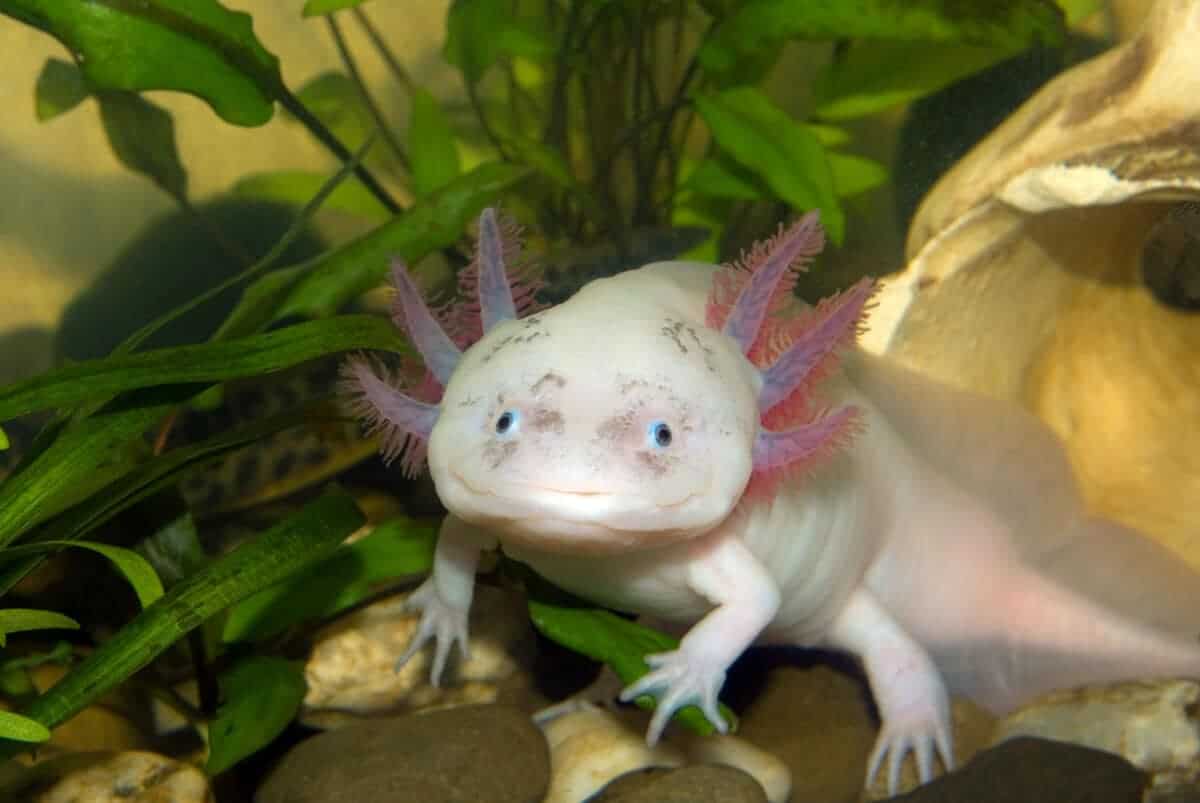
| Scientific Name | Ambystoma mexicanum |
| Where It Lives | Lake Xochimilco and Lake Chalco in Mexico |
| What It Eats | Worms, insects, arthropods, and mollusks |
| Conservation Status | Critically Endangered (CR) according to the IUCN Red List |
Fun Fact: Axolotls can regenerate any body part, including their spines.
The odd-looking Axolotl is native only to the freshwater of Lake Xochimilco in Mexico! Once also found in Lake Chalco, but the group there no longer exists.
The names of these amphibians aren’t the only strange thing about them. Axolotls have both gills and lungs that enable them to live underwater indefinitely. And that is usually what these solitary animals choose to do. Different than other amphibians, Axolotls reach maturity without going through metamorphosis. These fascinating creatures intrigue many scientists with their ability to regrow limbs, gills, part of their eyes, and brains even!
25. Aye Aye
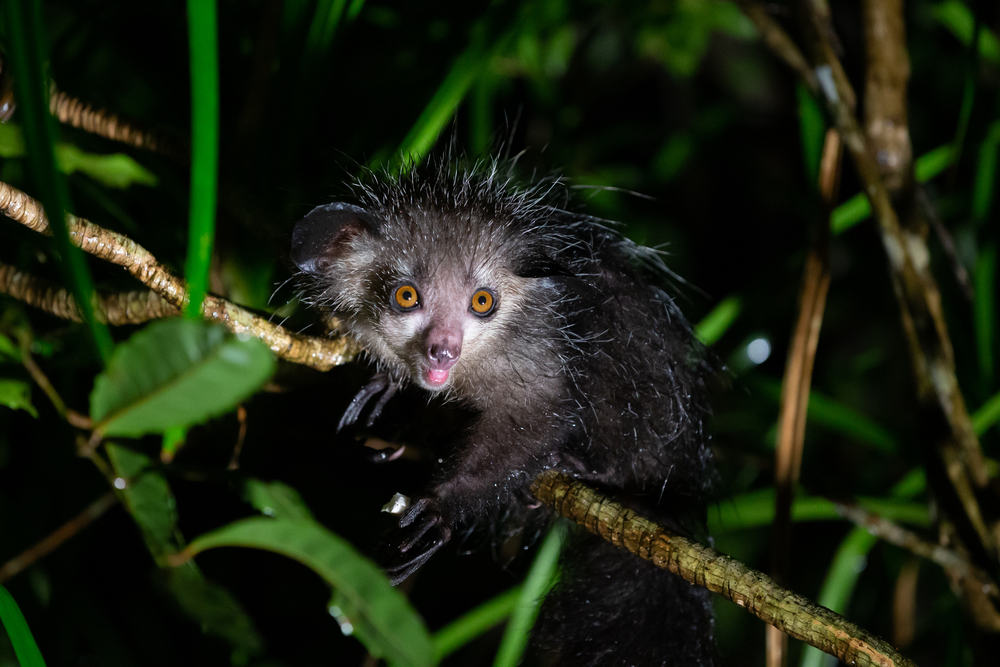
| Scientific Name | Daubentonia madagascariensis |
| Where It Lives | Madagascar |
| What It Eats | Nuts, fruits, seeds, honey, nectar, plant exudates and fungi, insect larvae |
| Conservation Status | Endangered (EN) according to the IUCN Red List |
Fun Fact: The Aye Aye’s incisors never stop growing throughout its life.
The Aye Aye is found only in deciduous forests, rainforests, plantations, and mangrove forests in Madagascar.
These nocturnal primates are listed as endangered, as locals used to kill them on the spot because it was believed to be terrible luck if one encounter an Aye Aye! These fur-covered animals have incredibly long fingers, the third being the thinnest of them all and are used for tapping. They even use these to scratch in their nose and eat the mucus they retrieve! Their fourth fingers are the longest and are used for pulling grubs and insects with their hooked nail. These lemurs received their name Aye-Aye from the sound ‘hai-hai’ that they make when feeling threatened.
Summary Of Animals That Start With A
From the anteater to the axolotl, many animals have names that start with a. These are just a few of them. We hope you enjoyed the list.
Extend your adventure with this list of Animals that start with F, letter G or letter H.
Or get the full list here:
- Animals That Start With B
- Animals That Start With C
- Animals That Start With D
- Animals That Start With E
- Animals That Start With F
- Animals That Start With G
- Animals That Start With H
- Animals That Start With I
- Animals That Start With J
- Animals That Start With K
- Animals That Start With L
- Animals That Start With M
- Animals That Start With N
- Animals That Start With O
- Animals That Start With P
- Animals That Start With Q
- Animals That Start With R
- Animals That Start With S
- Animals That Start With T
- Animals That Start With U
- Animals That Start With V
- Animals That Start With W
- Animals That Start With X
- Animals That Start With Y
- Animals That Start With Z
Thank you for reading. We hope you enjoyed it.
Join our Forum for free today!

- These are The 5 Largest Great White Sharks Ever Recorded - July 19, 2024
- The Surprising Benefits of Big Game Hunting - July 18, 2024
- $100k+ Hunting Experiences The Most Expensive Animals to Pursue - July 17, 2024

